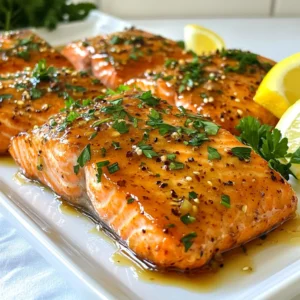
Maple Glazed Salmon
A delicious salmon dish glazed with a sweet and savory maple syrup marinade.
Ingredients
- 4 fillets salmon
- 0.25 cup pure maple syrup
- 2 tablespoons soy sauce
- 1 tablespoon Dijon mustard
- 2 cloves garlic, minced
- 1 tablespoon fresh ginger, grated
- to taste salt and pepper
- 1 tablespoon olive oil
- for garnish fresh parsley, chopped
- for serving lemon wedges
Instructions
- In a small bowl, whisk together the maple syrup, soy sauce, Dijon mustard, minced garlic, and grated ginger until well combined.
- Place the salmon fillets in a shallow dish or a resealable plastic bag and pour the marinade over them. Make sure each fillet is well coated. Marinate for at least 30 minutes, or up to 2 hours in the refrigerator for enhanced flavor.
- Preheat your oven to 400°F (200°C). Line a baking sheet with parchment paper and lightly brush it with olive oil to prevent sticking.
- Remove the salmon from the marinade, letting any excess drip off, and place the fillets on the prepared baking sheet. Discard the remaining marinade.
- Season the salmon fillets with salt and pepper.
- Bake the salmon in the preheated oven for 12-15 minutes, or until the salmon flakes easily with a fork and is cooked to your desired doneness.
- For an extra caramelized finish, turn on the broiler for the last 2-3 minutes of cooking, keeping a close eye to prevent burning.
- Remove the salmon from the oven and let it rest for a few minutes.
- Garnish with freshly chopped parsley and serve with lemon wedges on the side for added brightness.
Notes
For a gluten-free option, use coconut aminos instead of soy sauce.